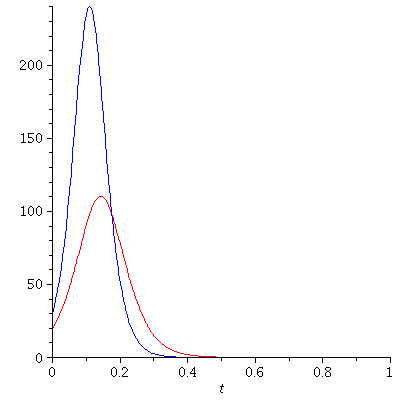Suppose that initially there are $n$ susceptibles and one infective. Let $X(t)$ denote a random variable which represents that number of susceptibles still uninfected at time $t$. The probability that $X(t)$ the value $r$ is $p_r(t)$. At time $t$, there are $X(t)$ susceptibles and $n-X(t)+1$ infectives. Assume that the chance of a new infection in a short time interval is proportional to the product of the number of susceptibles, the number of infectives and the length of the interval. Then the chance of an infection in $\Delta t$ is given by $\beta X(t)(n-X(t)+1)\Delta t$, where $\beta$ is the contact rate. For simplicity, we change the time scale to $\tau=\beta t$. The chance then becomes $X(n-X+1)\Delta\tau$. Denote by $p_r(\tau)$ the probability that there are still $r$ susceptibles remaining uninfected at $\tau$. There are two possibilities that can occur at time $\tau+\Delta\tau$: There are either $r+1$ susceptibles at $\tau$ followed by a new infection with probability $(r+1)(n-r)\Delta\tau$ , or $r$ susceptibles at $\tau$ followed by no infection with probability $1-r(n-r+1)\Delta\tau$. Thus $p_r(\tau+\Delta\tau)$, the probability of $r$ susceptibles remaining at time $\tau+\Delta\tau$ is given by $$p_r(\tau+\Delta\tau)=(r+1)(n-r)\Delta\tau p_{r+1}(\tau)+\{1-r(n-r+1)\Delta\tau\}p_r(\tau)$$ from which we obtain the differential-difference equation \begin{align*}\frac{dp_r(\tau)}{d\tau}&=\lim_{\Delta\tau\to 0}\frac{p_r(\tau+\Delta\tau)-p_r(\tau)}{\Delta\tau}\\&=(r+1)(n-r)p_{r+1}(\tau)-r(n-r+1)p_r(\tau)\end{align*} where $0\leq r\leq n-1$. For $r=n$ at $\tau+\Delta\tau$, there are $n$ susceptibles at $\tau$ followed by no new infection with probability $1-n\Delta\tau$. Thus we have $$p_n(\tau+\Delta\tau)=(1-n\Delta\tau)p_n(\tau)$$ and $$\frac{dp_n}{d\tau}=-np_n(\tau)$$ At $\tau=0$, there is only one infective, so we have the initial condition $p_n(0)=1$. We now have the system of differential-difference equations \begin{equation}\label{eq:stocepidemic}\frac{dp_r(\tau)}{d\tau}=(r+1)(n-r)p_{r+1}(\tau)-r(n-r+1)p_r,\ 0\leq r\leq n\end{equation} with initial condition $p_n(0)=1$.
One may attempt to solve the system \eqref{eq:stocepidemic} of differential-difference equations successively, similarly to that of the Poisson distribution (see here). The first three solutions are given by \begin{align*}p_n(\tau)&=e^{-n\tau}\\p_{n-1}(\tau)&=\frac{n}{n-1}[1-e^{-(n-1)\tau}]e^{-(n-1)\tau}\\p_{n-1}(\tau)&=\frac{2n}{2n-5}e^{-(n-1)\tau}-\frac{2n}{n-4}e^{-2(n-1)\tau}+\frac{2n(n-1)}{(n-4)(2n-5)}e^{-3(n-2)\tau}\end{align*} It is already difficult to see any recognizable pattern that may lead us to a general form of the solution. There are alternative ways to solve \eqref{eq:stocepidemic}, one of which is by using a generating function (see here). Let $P(x,r)=\sum_{r=0}^np_r(\tau)x^r$. Multiplying \eqref{eq:stocepidemic} by $x^r$ and summing the result over $r$ from $r=0$ to $r=n$, we obtain the partial differential equation $$\frac{\partial P}{\partial\tau}=(1-x)\left\{n\frac{\partial P}{\partial x}-x\frac{\partial^2 P}{\partial x^2}\right\}$$ with initial condition $P(x,0)=x^n$.
References:
- Norman T. J. Bailey, A Simple Stochastic Epidemic, Biometrika, Vol. 37, No. 3/4 (Dec., 1950), 193-202.
- The Mathematical Theory of Infectious Diseases and Its Applications, Norman T. J. Bailey, Second Edition, Charles Griffin & Company LTD, 1975.

